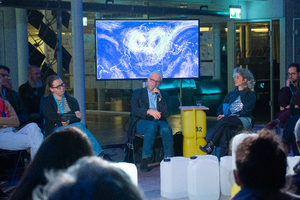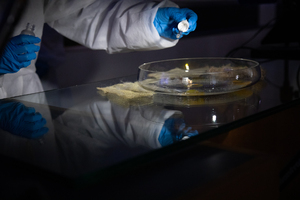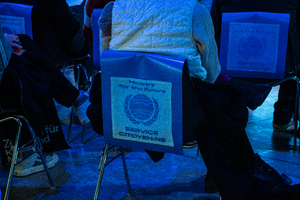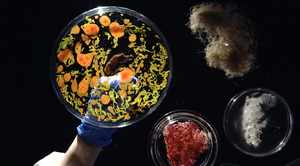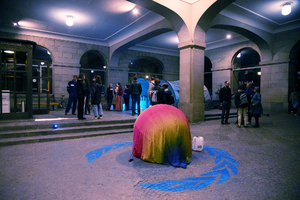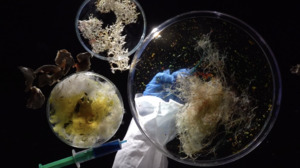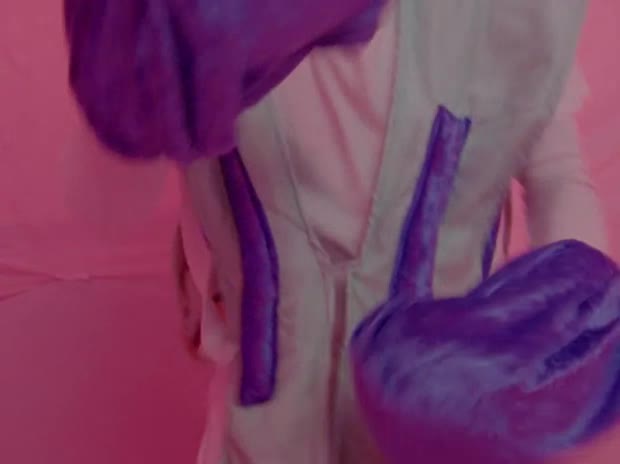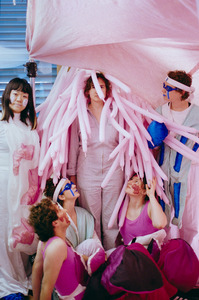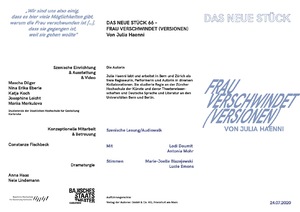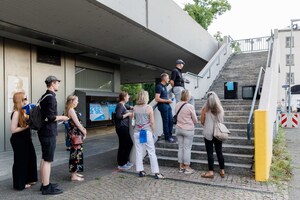Josephine Leicht
| Name | Josephine Leicht |
57 Inhalte
- Seite 1 von 5
Ministry for the Future, Episode 1 - Event
- Titel
- Ministry for the Future, Episode 1 - Event
- Autor/in
- Beschreibung (de)
- Ministry for the Future ist eine transdisziplinäre Produktion über mögliche Zukünfte im Angesicht der Klimakrise – und darüber, wie wir sie verhandeln, bevor sie eintreten. Inspiriert vom gleichnamigen Roman von Kim Stanley Robinson entwickelte sich ein groß angelegtes Kooperationsprojekt zwischen dem Theater Neumarkt, dem Collegium Helveticum Zürich und der Hochschule für Gestaltung Karlsruhe.
Ausgangspunkt ist ein spekulatives Szenario im Jahr 2034: Die Erde hat Kipppunkte erreicht, Regierungen reagieren, eine neue Institution wird gegründet – das Ministerium für die Zukunft. Innerhalb dieser Fiktion operiert die Produktion als diskursives Format, das sich fortlaufend mit der zentralen Frage auseinandersetzt: Welche Handlungsspielräume bleiben uns?
Das Projekt kombiniert künstlerische, wissenschaftliche und gestalterische Perspektiven zu einem Format zwischen Preenactment und realer Wissenschaftskommunikation. Herzstück ist ein mobiles Bühnenbild, das drängende forschungsbasierte Diskurse in eine begehbare, funktionale Infrastruktur übersetzt. Die Szenografie wurde konsequent durch Re- und Upcycling-Prozesse entwickelt. Sie folgt einer Haltung, die den Anforderungen ökologischer Krisen standhalten will – indem sie aus dem Material jener Krisen selbst hervorgeht. In vier thematisch fokussierten Episoden an vier verschiedenen Orten in Zürich wird der Raum selbst zum Instrument: eine spekulative Versammlung, eine temporäre Institution, ein Möglichkeitslabor.
Die Inszenierung bringt reale Wissenschaftler:innen, Performer:innen und Bürger:innen im Modus eines fiktionalen Ministeriums in Austausch – und mit ihnen die Fragen: Wie lässt sich Zukunft verhandeln, wenn sie längst begonnen hat? Was bedeutet Teilhabe, wenn die Katastrophe strukturell geworden ist? Und wie kann Raum für solche Aushandlungen heute aussehen?
- Ministry for the Future ist eine transdisziplinäre Produktion über mögliche Zukünfte im Angesicht der Klimakrise – und darüber, wie wir sie verhandeln, bevor sie eintreten. Inspiriert vom gleichnamigen Roman von Kim Stanley Robinson entwickelte sich ein groß angelegtes Kooperationsprojekt zwischen dem Theater Neumarkt, dem Collegium Helveticum Zürich und der Hochschule für Gestaltung Karlsruhe.
- Beschreibung (en)
- Ministry for the Future is a transdisciplinary production about possible futures in the face of the climate crisis—and about how we negotiate them before they arrive. Inspired by the novel of the same name by Kim Stanley Robinson, the project evolved into a large-scale collaboration between Theater Neumarkt, the Collegium Helveticum Zurich, and the Karlsruhe University of Arts and Design (HfG).
Its starting point is a speculative scenario set in the year 2034: the Earth has reached tipping points, governments are reacting, and a new institution is established—the Ministry for the Future. Within this fiction, the production functions as a discursive format that continuously engages with the central question: What room for action remains?
The project combines artistic, scientific, and design perspectives into a hybrid format somewhere between preenactment and real science communication. At its core is a mobile stage design that translates urgent, research-based discourses into an immersive, functional infrastructure. The scenography was developed entirely through re- and upcycling processes, guided by an attitude that seeks to meet the demands of ecological crises—by emerging from their very material. Across four thematically focused episodes in four different locations in Zurich, the space itself becomes an instrument: a speculative assembly, a temporary institution, a lab of possibilities.
The performance brings together real scientists, performers, and citizens within the framework of a fictional ministry—and with them, the questions: How can we negotiate the future when it has already begun? What does participation mean when catastrophe has become structural? And what kind of space is needed for such negotiations today?
- Ministry for the Future is a transdisciplinary production about possible futures in the face of the climate crisis—and about how we negotiate them before they arrive. Inspired by the novel of the same name by Kim Stanley Robinson, the project evolved into a large-scale collaboration between Theater Neumarkt, the Collegium Helveticum Zurich, and the Karlsruhe University of Arts and Design (HfG).
- Kategorie
- Typ des Projekts/Werks
- Schlagworte
- Datierung
- 14.02.2025 - 25.04.2025
- Mitwirkende
- Sprache
- Ort: Institution
- Stadt
- Land
- Beteiligte Institution(en)
- Internetlinks
- Titel
- Ministry for the Future, Episode 1 - Event
- Titel (en)
- Ministry for the Future, Episode 1 - event
- Urheberrechtshinweis
- © Collegium Helveticum
- Rechtsschutz/Lizenz
- Freigabe Nutzung HfG
- Medienersteller/in
- Beziehung/Funktion
- Medien-Beschreibung
- Wissenschaftskommunikation
Wissenschaftliches Denken wird nicht nur vermittelt, sondern verhandelt. In dieser Inszenierung treffen sich reale Wissenschaftler:innen aus Klima-, Sozial- und Zukunftsforschung und der Bürger:innenrat -das Publikum- auf Augenhöhe. Gemeinsam werden sie zu Akteur:innen eines kollektiven Nachdenkens. Die Bühne fungiert als Kommunikationsraum, in dem sich Fakten, Unsicherheiten und ethische Fragen gleichberechtigt begegnen – ein Diskurs in Echtzeit.
Teilhabe und Verantwortung
Das Publikum ist eingeladen, Teil einer spekulativen Institution zu werden: des Ministeriums für die Zukunft. Durch offene Sitzordnungen, modulare Raumformate und diskursive Interventionen wird die klassische Zuschauer:innenrolle aufgelöst. Alle sind Akteur:innen in der kollektiven Auseinandersetzung. Ministry for the Future denkt Teilhabe als strukturelles Prinzip – auch in der Gestaltung der Orte selbst.
- Wissenschaftskommunikation
- Medien-Beschreibung (en)
- Science Communication
Scientific thinking is not only conveyed, but negotiated. In this performance, real scientists from the fields of climate, social, and futures research meet with the citizens’ assembly—the audience—on equal footing. Together they become actors in a collective process of reflection. The stage functions as a space of communication where facts, uncertainties, and ethical questions interact on equal terms—a discourse in real time.
Participation and Responsibility
The audience is invited to become part of a speculative institution: the Ministry for the Future. Through open seating arrangements, modular spatial formats, and discursive interventions, the classical role of the spectator is dissolved. Everyone becomes an actor in the collective engagement. Ministry for the Future treats participation as a structural principle—even in the shaping of the spaces themselves.
- Science Communication
- Abgebildete Personen
- Projektleiter/in
- Semester
- Studiengang
- Importiert am
- 29.06.2025
- Übergeordnete Sets
- 1
Ministry for the Future, Episode 2 - Live Show
- Titel
- Ministry for the Future, Episode 2 - Live Show
- Autor/in
- Beschreibung (de)
- Ministry for the Future ist eine transdisziplinäre Produktion über mögliche Zukünfte im Angesicht der Klimakrise – und darüber, wie wir sie verhandeln, bevor sie eintreten. Inspiriert vom gleichnamigen Roman von Kim Stanley Robinson entwickelte sich ein groß angelegtes Kooperationsprojekt zwischen dem Theater Neumarkt, dem Collegium Helveticum Zürich und der Hochschule für Gestaltung Karlsruhe.
Ausgangspunkt ist ein spekulatives Szenario im Jahr 2034: Die Erde hat Kipppunkte erreicht, Regierungen reagieren, eine neue Institution wird gegründet – das Ministerium für die Zukunft. Innerhalb dieser Fiktion operiert die Produktion als diskursives Format, das sich fortlaufend mit der zentralen Frage auseinandersetzt: Welche Handlungsspielräume bleiben uns?
Das Projekt kombiniert künstlerische, wissenschaftliche und gestalterische Perspektiven zu einem Format zwischen Preenactment und realer Wissenschaftskommunikation. Herzstück ist ein mobiles Bühnenbild, das drängende forschungsbasierte Diskurse in eine begehbare, funktionale Infrastruktur übersetzt. Die Szenografie wurde konsequent durch Re- und Upcycling-Prozesse entwickelt. Sie folgt einer Haltung, die den Anforderungen ökologischer Krisen standhalten will – indem sie aus dem Material jener Krisen selbst hervorgeht. In vier thematisch fokussierten Episoden an vier verschiedenen Orten in Zürich wird der Raum selbst zum Instrument: eine spekulative Versammlung, eine temporäre Institution, ein Möglichkeitslabor.
Die Inszenierung bringt reale Wissenschaftler:innen, Performer:innen und Bürger:innen im Modus eines fiktionalen Ministeriums in Austausch – und mit ihnen die Fragen: Wie lässt sich Zukunft verhandeln, wenn sie längst begonnen hat? Was bedeutet Teilhabe, wenn die Katastrophe strukturell geworden ist? Und wie kann Raum für solche Aushandlungen heute aussehen?
- Ministry for the Future ist eine transdisziplinäre Produktion über mögliche Zukünfte im Angesicht der Klimakrise – und darüber, wie wir sie verhandeln, bevor sie eintreten. Inspiriert vom gleichnamigen Roman von Kim Stanley Robinson entwickelte sich ein groß angelegtes Kooperationsprojekt zwischen dem Theater Neumarkt, dem Collegium Helveticum Zürich und der Hochschule für Gestaltung Karlsruhe.
- Beschreibung (en)
-
Ministry for the Future is a transdisciplinary production about possible futures in the face of the climate crisis—and about how we negotiate them before they arrive. Inspired by the novel of the same name by Kim Stanley Robinson, the project evolved into a large-scale collaboration between Theater Neumarkt, the Collegium Helveticum Zurich, and the Karlsruhe University of Arts and Design (HfG).
Its starting point is a speculative scenario set in the year 2034: the Earth has reached tipping points, governments are reacting, and a new institution is established—the Ministry for the Future. Within this fiction, the production functions as a discursive format that continuously engages with the central question: What room for action remains?
The project combines artistic, scientific, and design perspectives into a hybrid format somewhere between preenactment and real science communication. At its core is a mobile stage design that translates urgent, research-based discourses into an immersive, functional infrastructure. The scenography was developed entirely through re- and upcycling processes, guided by an attitude that seeks to meet the demands of ecological crises—by emerging from their very material. Across four thematically focused episodes in four different locations in Zurich, the space itself becomes an instrument: a speculative assembly, a temporary institution, a lab of possibilities.
The performance brings together real scientists, performers, and citizens within the framework of a fictional ministry—and with them, the questions: How can we negotiate the future when it has already begun? What does participation mean when catastrophe has become structural? And what kind of space is needed for such negotiations today?
-
- Kategorie
- Typ des Projekts/Werks
- Schlagworte
- Datierung
- 14.02.2025 - 25.04.2025
- Mitwirkende
- Sprache
- Ort: Institution
- Beteiligte Institution(en)
- Internetlinks
- Titel
- Ministry for the Future, Episode 2 - Live Show
- Titel (en)
- Ministry for the Future, Episode 2 - Live Show
- Urheberrechtshinweis
- © Collegium Helveticum Zürich
- Rechtsschutz/Lizenz
- Freigabe Nutzung HfG
- Medienersteller/in
- Beziehung/Funktion
- Medien-Beschreibung
- Wissenschaftskommunikation
Wissenschaftliches Denken wird nicht nur vermittelt, sondern verhandelt. In dieser Inszenierung treffen sich reale Wissenschaftler:innen aus Klima-, Sozial- und Zukunftsforschung und der Bürger:innenrat -das Publikum- auf Augenhöhe. Gemeinsam werden sie zu Akteur:innen eines kollektiven Nachdenkens. Die Bühne fungiert als Kommunikationsraum, in dem sich Fakten, Unsicherheiten und ethische Fragen gleichberechtigt begegnen – ein Diskurs in Echtzeit.
Situative Platznahme
Ministry for the Future versteht Intervention als situative Platznahme in öffentlichen, wissenschaftlichen und ästhetischen Räumen. In Form des fiktiven Ministeriums werden temporäre Infrastrukturen geschaffen, die unterstützen oder auch Reibung erzeugen.
An vier Orten in Zürich reagiert das mobile Set auf konkrete räumliche, institutionelle und thematische Kontexte: als installative Präsenz, als Gesprächsarchitektur, als spekulative Behörde oder als gezielte Störung. Intendiert ist damit weniger ein Bruch als ein Angebot – im Einschreiben einer möglichen Zukunft in die Logik des Hier und Jetzt.
- Wissenschaftskommunikation
- Medien-Beschreibung (en)
- Science Communication
Scientific thinking is not only conveyed, but negotiated. In this performance, real scientists from the fields of climate, social, and futures research meet with the citizens’ assembly—the audience—on equal footing. Together they become actors in a collective process of reflection. The stage functions as a space of communication where facts, uncertainties, and ethical questions interact on equal terms—a discourse in real time.
Situational Occupation of Space
Ministry for the Future understands intervention as situational occupation—within public, scientific, and aesthetic spaces. In the form of the fictional ministry, temporary infrastructures are created that either support or disrupt. In four locations in Zurich, the mobile set responds to concrete spatial, institutional, and thematic contexts: as an installative presence, as conversation architecture, as speculative authority, or as deliberate provocation. The aim is not rupture, but offering—a way of inscribing a possible future into the logic of the present.
- Science Communication
- Abgebildete Personen
- Projektleiter/in
- Semester
- Studiengang
- Importiert am
- 29.06.2025
- Übergeordnete Sets
- 1
Ministry for the Future, Episode 2 - Live Show
- Titel
- Ministry for the Future, Episode 2 - Live Show
- Autor/in
- Beschreibung (de)
- Ministry for the Future ist eine transdisziplinäre Produktion über mögliche Zukünfte im Angesicht der Klimakrise – und darüber, wie wir sie verhandeln, bevor sie eintreten. Inspiriert vom gleichnamigen Roman von Kim Stanley Robinson entwickelte sich ein groß angelegtes Kooperationsprojekt zwischen dem Theater Neumarkt, dem Collegium Helveticum Zürich und der Hochschule für Gestaltung Karlsruhe.
Ausgangspunkt ist ein spekulatives Szenario im Jahr 2034: Die Erde hat Kipppunkte erreicht, Regierungen reagieren, eine neue Institution wird gegründet – das Ministerium für die Zukunft. Innerhalb dieser Fiktion operiert die Produktion als diskursives Format, das sich fortlaufend mit der zentralen Frage auseinandersetzt: Welche Handlungsspielräume bleiben uns?
Das Projekt kombiniert künstlerische, wissenschaftliche und gestalterische Perspektiven zu einem Format zwischen Preenactment und realer Wissenschaftskommunikation. Herzstück ist ein mobiles Bühnenbild, das drängende forschungsbasierte Diskurse in eine begehbare, funktionale Infrastruktur übersetzt. Die Szenografie wurde konsequent durch Re- und Upcycling-Prozesse entwickelt. Sie folgt einer Haltung, die den Anforderungen ökologischer Krisen standhalten will – indem sie aus dem Material jener Krisen selbst hervorgeht. In vier thematisch fokussierten Episoden an vier verschiedenen Orten in Zürich wird der Raum selbst zum Instrument: eine spekulative Versammlung, eine temporäre Institution, ein Möglichkeitslabor.
Die Inszenierung bringt reale Wissenschaftler:innen, Performer:innen und Bürger:innen im Modus eines fiktionalen Ministeriums in Austausch – und mit ihnen die Fragen: Wie lässt sich Zukunft verhandeln, wenn sie längst begonnen hat? Was bedeutet Teilhabe, wenn die Katastrophe strukturell geworden ist? Und wie kann Raum für solche Aushandlungen heute aussehen?
- Ministry for the Future ist eine transdisziplinäre Produktion über mögliche Zukünfte im Angesicht der Klimakrise – und darüber, wie wir sie verhandeln, bevor sie eintreten. Inspiriert vom gleichnamigen Roman von Kim Stanley Robinson entwickelte sich ein groß angelegtes Kooperationsprojekt zwischen dem Theater Neumarkt, dem Collegium Helveticum Zürich und der Hochschule für Gestaltung Karlsruhe.
- Beschreibung (en)
-
Ministry for the Future is a transdisciplinary production about possible futures in the face of the climate crisis—and about how we negotiate them before they arrive. Inspired by the novel of the same name by Kim Stanley Robinson, the project evolved into a large-scale collaboration between Theater Neumarkt, the Collegium Helveticum Zurich, and the Karlsruhe University of Arts and Design (HfG).
Its starting point is a speculative scenario set in the year 2034: the Earth has reached tipping points, governments are reacting, and a new institution is established—the Ministry for the Future. Within this fiction, the production functions as a discursive format that continuously engages with the central question: What room for action remains?
The project combines artistic, scientific, and design perspectives into a hybrid format somewhere between preenactment and real science communication. At its core is a mobile stage design that translates urgent, research-based discourses into an immersive, functional infrastructure. The scenography was developed entirely through re- and upcycling processes, guided by an attitude that seeks to meet the demands of ecological crises—by emerging from their very material. Across four thematically focused episodes in four different locations in Zurich, the space itself becomes an instrument: a speculative assembly, a temporary institution, a lab of possibilities.
The performance brings together real scientists, performers, and citizens within the framework of a fictional ministry—and with them, the questions: How can we negotiate the future when it has already begun? What does participation mean when catastrophe has become structural? And what kind of space is needed for such negotiations today?
-
- Kategorie
- Typ des Projekts/Werks
- Schlagworte
- Datierung
- 14.02.2025 - 25.04.2025
- Mitwirkende
- Dank an
- Sprache
- Ort: Institution
- Beteiligte Institution(en)
- Internetlinks
- Titel
- Ministry for the Future, Episode 2 - Live Show
- Titel (en)
- Ministry for the Future, Episode 2 - Live Show
- Urheberrechtshinweis
- © Staatliche Hochschule für Gestaltung Karlsruhe
- Rechtsschutz/Lizenz
- Freigabe Nutzung HfG
- Medienersteller/in
- Beziehung/Funktion
- Medien-Beschreibung
- Wissenschaftskommunikation
Wissenschaftliches Denken wird nicht nur vermittelt, sondern verhandelt. In dieser Inszenierung treffen sich reale Wissenschaftler:innen aus Klima-, Sozial- und Zukunftsforschung und der Bürger:innenrat -das Publikum- auf Augenhöhe. Gemeinsam werden sie zu Akteur:innen eines kollektiven Nachdenkens. Die Bühne fungiert als Kommunikationsraum, in dem sich Fakten, Unsicherheiten und ethische Fragen gleichberechtigt begegnen – ein Diskurs in Echtzeit.
Situative Platznahme
Ministry for the Future versteht Intervention als situative Platznahme in öffentlichen, wissenschaftlichen und ästhetischen Räumen. In Form des fiktiven Ministeriums werden temporäre Infrastrukturen geschaffen, die unterstützen oder auch Reibung erzeugen.
An vier Orten in Zürich reagiert das mobile Set auf konkrete räumliche, institutionelle und thematische Kontexte: als installative Präsenz, als Gesprächsarchitektur, als spekulative Behörde oder als gezielte Störung. Intendiert ist damit weniger ein Bruch als ein Angebot – im Einschreiben einer möglichen Zukunft in die Logik des Hier und Jetzt.
- Wissenschaftskommunikation
- Medien-Beschreibung (en)
- Science Communication
Scientific thinking is not only conveyed, but negotiated. In this performance, real scientists from the fields of climate, social, and futures research meet with the citizens’ assembly—the audience—on equal footing. Together they become actors in a collective process of reflection. The stage functions as a space of communication where facts, uncertainties, and ethical questions interact on equal terms—a discourse in real time.
Situational Occupation of Space
Ministry for the Future understands intervention as situational occupation—within public, scientific, and aesthetic spaces. In the form of the fictional ministry, temporary infrastructures are created that either support or disrupt. In four locations in Zurich, the mobile set responds to concrete spatial, institutional, and thematic contexts: as an installative presence, as conversation architecture, as speculative authority, or as deliberate provocation. The aim is not rupture, but offering—a way of inscribing a possible future into the logic of the present.
- Science Communication
- Projektleiter/in
- Semester
- Studiengang
- Importiert am
- 29.06.2025
- Übergeordnete Sets
- 1
Ministry for the Future, Episode 1 - Detail
- Titel
- Ministry for the Future, Episode 1 - Detail
- Autor/in
- Beschreibung (de)
- Ministry for the Future ist eine transdisziplinäre Produktion über mögliche Zukünfte im Angesicht der Klimakrise – und darüber, wie wir sie verhandeln, bevor sie eintreten. Inspiriert vom gleichnamigen Roman von Kim Stanley Robinson entwickelte sich ein groß angelegtes Kooperationsprojekt zwischen dem Theater Neumarkt, dem Collegium Helveticum Zürich und der Hochschule für Gestaltung Karlsruhe.
Ausgangspunkt ist ein spekulatives Szenario im Jahr 2034: Die Erde hat Kipppunkte erreicht, Regierungen reagieren, eine neue Institution wird gegründet – das Ministerium für die Zukunft. Innerhalb dieser Fiktion operiert die Produktion als diskursives Format, das sich fortlaufend mit der zentralen Frage auseinandersetzt: Welche Handlungsspielräume bleiben uns?
Das Projekt kombiniert künstlerische, wissenschaftliche und gestalterische Perspektiven zu einem Format zwischen Preenactment und realer Wissenschaftskommunikation. Herzstück ist ein mobiles Bühnenbild, das drängende forschungsbasierte Diskurse in eine begehbare, funktionale Infrastruktur übersetzt. Die Szenografie wurde konsequent durch Re- und Upcycling-Prozesse entwickelt. Sie folgt einer Haltung, die den Anforderungen ökologischer Krisen standhalten will – indem sie aus dem Material jener Krisen selbst hervorgeht. In vier thematisch fokussierten Episoden an vier verschiedenen Orten in Zürich wird der Raum selbst zum Instrument: eine spekulative Versammlung, eine temporäre Institution, ein Möglichkeitslabor.
Die Inszenierung bringt reale Wissenschaftler:innen, Performer:innen und Bürger:innen im Modus eines fiktionalen Ministeriums in Austausch – und mit ihnen die Fragen: Wie lässt sich Zukunft verhandeln, wenn sie längst begonnen hat? Was bedeutet Teilhabe, wenn die Katastrophe strukturell geworden ist? Und wie kann Raum für solche Aushandlungen heute aussehen?
- Ministry for the Future ist eine transdisziplinäre Produktion über mögliche Zukünfte im Angesicht der Klimakrise – und darüber, wie wir sie verhandeln, bevor sie eintreten. Inspiriert vom gleichnamigen Roman von Kim Stanley Robinson entwickelte sich ein groß angelegtes Kooperationsprojekt zwischen dem Theater Neumarkt, dem Collegium Helveticum Zürich und der Hochschule für Gestaltung Karlsruhe.
- Beschreibung (en)
- Ministry for the Future is a transdisciplinary production about possible futures in the face of the climate crisis—and about how we negotiate them before they arrive. Inspired by the novel of the same name by Kim Stanley Robinson, the project evolved into a large-scale collaboration between Theater Neumarkt, the Collegium Helveticum Zurich, and the Karlsruhe University of Arts and Design (HfG).
Its starting point is a speculative scenario set in the year 2034: the Earth has reached tipping points, governments are reacting, and a new institution is established—the Ministry for the Future. Within this fiction, the production functions as a discursive format that continuously engages with the central question: What room for action remains?
The project combines artistic, scientific, and design perspectives into a hybrid format somewhere between preenactment and real science communication. At its core is a mobile stage design that translates urgent, research-based discourses into an immersive, functional infrastructure. The scenography was developed entirely through re- and upcycling processes, guided by an attitude that seeks to meet the demands of ecological crises—by emerging from their very material. Across four thematically focused episodes in four different locations in Zurich, the space itself becomes an instrument: a speculative assembly, a temporary institution, a lab of possibilities.
The performance brings together real scientists, performers, and citizens within the framework of a fictional ministry—and with them, the questions: How can we negotiate the future when it has already begun? What does participation mean when catastrophe has become structural? And what kind of space is needed for such negotiations today?
- Ministry for the Future is a transdisciplinary production about possible futures in the face of the climate crisis—and about how we negotiate them before they arrive. Inspired by the novel of the same name by Kim Stanley Robinson, the project evolved into a large-scale collaboration between Theater Neumarkt, the Collegium Helveticum Zurich, and the Karlsruhe University of Arts and Design (HfG).
- Kategorie
- Typ des Projekts/Werks
- Schlagworte
- Datierung
- 14.02.2025 - 25.04.2025
- Mitwirkende
- Sprache
- Ort: Institution
- Stadt
- Land
- Beteiligte Institution(en)
- Internetlinks
- Titel
- Ministry for the Future, Episode 1 - Detail
- Titel (en)
- Ministry for the Future, Episode 1 - detail
- Urheberrechtshinweis
- © Collegium Helveticum
- Rechtsschutz/Lizenz
- Freigabe Nutzung HfG
- Medienersteller/in
- Beziehung/Funktion
- Medien-Beschreibung
- Krisenästhetik
Ministry for the Future denkt Zukunft als materielle Praxis im Krisenmodus der planetaren Erschöpfung. Die Szenografie wird dabei selbst zum Statement: Modular, mobil, weitgehend aus wiederverwendeten Materialien gefertigt, nimmt sie die Krise nicht nur als Thema, sondern als Produktionsbedingung ernst. Statt dystopischer Illustration oder unbegrenzter Technikvision wird ein ästhetischer Umgang mit Funktion, Knappheit und Transformation vorgeschlagen – resilient, improvisiert, offen
- Krisenästhetik
- Medien-Beschreibung (en)
- Aesthetics of Crisis
Ministry for the Future imagines the future as a material practice within the crisis mode of planetary exhaustion. The scenography becomes a statement in itself: modular, mobile, largely made from reused materials—it takes the crisis not only as its theme but as a condition of production. Instead of dystopian illustration or limitless technological visions, it proposes an aesthetic approach to function, scarcity, and transformation—resilient, improvised, open.
- Aesthetics of Crisis
- Projektleiter/in
- Semester
- Studiengang
- Importiert am
- 29.06.2025
- Übergeordnete Sets
- 1
Ministry for the Future, Episode 2 - Live Show
- Titel
- Ministry for the Future, Episode 2 - Live Show
- Autor/in
- Beschreibung (de)
- Ministry for the Future ist eine transdisziplinäre Produktion über mögliche Zukünfte im Angesicht der Klimakrise – und darüber, wie wir sie verhandeln, bevor sie eintreten. Inspiriert vom gleichnamigen Roman von Kim Stanley Robinson entwickelte sich ein groß angelegtes Kooperationsprojekt zwischen dem Theater Neumarkt, dem Collegium Helveticum Zürich und der Hochschule für Gestaltung Karlsruhe.
Ausgangspunkt ist ein spekulatives Szenario im Jahr 2034: Die Erde hat Kipppunkte erreicht, Regierungen reagieren, eine neue Institution wird gegründet – das Ministerium für die Zukunft. Innerhalb dieser Fiktion operiert die Produktion als diskursives Format, das sich fortlaufend mit der zentralen Frage auseinandersetzt: Welche Handlungsspielräume bleiben uns?
Das Projekt kombiniert künstlerische, wissenschaftliche und gestalterische Perspektiven zu einem Format zwischen Preenactment und realer Wissenschaftskommunikation. Herzstück ist ein mobiles Bühnenbild, das drängende forschungsbasierte Diskurse in eine begehbare, funktionale Infrastruktur übersetzt. Die Szenografie wurde konsequent durch Re- und Upcycling-Prozesse entwickelt. Sie folgt einer Haltung, die den Anforderungen ökologischer Krisen standhalten will – indem sie aus dem Material jener Krisen selbst hervorgeht. In vier thematisch fokussierten Episoden an vier verschiedenen Orten in Zürich wird der Raum selbst zum Instrument: eine spekulative Versammlung, eine temporäre Institution, ein Möglichkeitslabor.
Die Inszenierung bringt reale Wissenschaftler:innen, Performer:innen und Bürger:innen im Modus eines fiktionalen Ministeriums in Austausch – und mit ihnen die Fragen: Wie lässt sich Zukunft verhandeln, wenn sie längst begonnen hat? Was bedeutet Teilhabe, wenn die Katastrophe strukturell geworden ist? Und wie kann Raum für solche Aushandlungen heute aussehen?
- Ministry for the Future ist eine transdisziplinäre Produktion über mögliche Zukünfte im Angesicht der Klimakrise – und darüber, wie wir sie verhandeln, bevor sie eintreten. Inspiriert vom gleichnamigen Roman von Kim Stanley Robinson entwickelte sich ein groß angelegtes Kooperationsprojekt zwischen dem Theater Neumarkt, dem Collegium Helveticum Zürich und der Hochschule für Gestaltung Karlsruhe.
- Beschreibung (en)
-
Ministry for the Future is a transdisciplinary production about possible futures in the face of the climate crisis—and about how we negotiate them before they arrive. Inspired by the novel of the same name by Kim Stanley Robinson, the project evolved into a large-scale collaboration between Theater Neumarkt, the Collegium Helveticum Zurich, and the Karlsruhe University of Arts and Design (HfG).
Its starting point is a speculative scenario set in the year 2034: the Earth has reached tipping points, governments are reacting, and a new institution is established—the Ministry for the Future. Within this fiction, the production functions as a discursive format that continuously engages with the central question: What room for action remains?
The project combines artistic, scientific, and design perspectives into a hybrid format somewhere between preenactment and real science communication. At its core is a mobile stage design that translates urgent, research-based discourses into an immersive, functional infrastructure. The scenography was developed entirely through re- and upcycling processes, guided by an attitude that seeks to meet the demands of ecological crises—by emerging from their very material. Across four thematically focused episodes in four different locations in Zurich, the space itself becomes an instrument: a speculative assembly, a temporary institution, a lab of possibilities.
The performance brings together real scientists, performers, and citizens within the framework of a fictional ministry—and with them, the questions: How can we negotiate the future when it has already begun? What does participation mean when catastrophe has become structural? And what kind of space is needed for such negotiations today?
-
- Kategorie
- Typ des Projekts/Werks
- Schlagworte
- Datierung
- 14.02.2025 - 25.04.2025
- Mitwirkende
- Dank an
- Sprache
- Ort: Institution
- Beteiligte Institution(en)
- Internetlinks
- Titel
- Ministry for the Future, Episode 2 - Live Show
- Titel (en)
- Ministry for the Future, Episode 2 - Live Show
- Urheberrechtshinweis
- © Staatliche Hochschule für Gestaltung Karlsruhe
- Rechtsschutz/Lizenz
- Freigabe Nutzung HfG
- Medienersteller/in
- Beziehung/Funktion
- Medien-Beschreibung
- Wissenschaftskommunikation
Wissenschaftliches Denken wird nicht nur vermittelt, sondern verhandelt. In dieser Inszenierung treffen sich reale Wissenschaftler:innen aus Klima-, Sozial- und Zukunftsforschung und der Bürger:innenrat -das Publikum- auf Augenhöhe. Gemeinsam werden sie zu Akteur:innen eines kollektiven Nachdenkens. Die Bühne fungiert als Kommunikationsraum, in dem sich Fakten, Unsicherheiten und ethische Fragen gleichberechtigt begegnen – ein Diskurs in Echtzeit.
Situative Platznahme
Ministry for the Future versteht Intervention als situative Platznahme in öffentlichen, wissenschaftlichen und ästhetischen Räumen. In Form des fiktiven Ministeriums werden temporäre Infrastrukturen geschaffen, die unterstützen oder auch Reibung erzeugen.
An vier Orten in Zürich reagiert das mobile Set auf konkrete räumliche, institutionelle und thematische Kontexte: als installative Präsenz, als Gesprächsarchitektur, als spekulative Behörde oder als gezielte Störung. Intendiert ist damit weniger ein Bruch als ein Angebot – im Einschreiben einer möglichen Zukunft in die Logik des Hier und Jetzt.
- Wissenschaftskommunikation
- Medien-Beschreibung (en)
- Science Communication
Scientific thinking is not only conveyed, but negotiated. In this performance, real scientists from the fields of climate, social, and futures research meet with the citizens’ assembly—the audience—on equal footing. Together they become actors in a collective process of reflection. The stage functions as a space of communication where facts, uncertainties, and ethical questions interact on equal terms—a discourse in real time.
Situational Occupation of Space
Ministry for the Future understands intervention as situational occupation—within public, scientific, and aesthetic spaces. In the form of the fictional ministry, temporary infrastructures are created that either support or disrupt. In four locations in Zurich, the mobile set responds to concrete spatial, institutional, and thematic contexts: as an installative presence, as conversation architecture, as speculative authority, or as deliberate provocation. The aim is not rupture, but offering—a way of inscribing a possible future into the logic of the present.
- Science Communication
- Projektleiter/in
- Semester
- Studiengang
- Importiert am
- 29.06.2025
- Übergeordnete Sets
- 1
Ministry for the Future, Episode 3 - Szenografie
- Titel
- Ministry for the Future, Episode 3 - Szenografie
- Autor/in
- Beschreibung (de)
- Ministry for the Future ist eine transdisziplinäre Produktion über mögliche Zukünfte im Angesicht der Klimakrise – und darüber, wie wir sie verhandeln, bevor sie eintreten. Inspiriert vom gleichnamigen Roman von Kim Stanley Robinson entwickelte sich ein groß angelegtes Kooperationsprojekt zwischen dem Theater Neumarkt, dem Collegium Helveticum Zürich und der Hochschule für Gestaltung Karlsruhe.
Ausgangspunkt ist ein spekulatives Szenario im Jahr 2034: Die Erde hat Kipppunkte erreicht, Regierungen reagieren, eine neue Institution wird gegründet – das Ministerium für die Zukunft. Innerhalb dieser Fiktion operiert die Produktion als diskursives Format, das sich fortlaufend mit der zentralen Frage auseinandersetzt: Welche Handlungsspielräume bleiben uns?
Das Projekt kombiniert künstlerische, wissenschaftliche und gestalterische Perspektiven zu einem Format zwischen Preenactment und realer Wissenschaftskommunikation. Herzstück ist ein mobiles Bühnenbild, das drängende forschungsbasierte Diskurse in eine begehbare, funktionale Infrastruktur übersetzt. Die Szenografie wurde konsequent durch Re- und Upcycling-Prozesse entwickelt. Sie folgt einer Haltung, die den Anforderungen ökologischer Krisen standhalten will – indem sie aus dem Material jener Krisen selbst hervorgeht. In vier thematisch fokussierten Episoden an vier verschiedenen Orten in Zürich wird der Raum selbst zum Instrument: eine spekulative Versammlung, eine temporäre Institution, ein Möglichkeitslabor.
Die Inszenierung bringt reale Wissenschaftler:innen, Performer:innen und Bürger:innen im Modus eines fiktionalen Ministeriums in Austausch – und mit ihnen die Fragen: Wie lässt sich Zukunft verhandeln, wenn sie längst begonnen hat? Was bedeutet Teilhabe, wenn die Katastrophe strukturell geworden ist? Und wie kann Raum für solche Aushandlungen heute aussehen?
- Ministry for the Future ist eine transdisziplinäre Produktion über mögliche Zukünfte im Angesicht der Klimakrise – und darüber, wie wir sie verhandeln, bevor sie eintreten. Inspiriert vom gleichnamigen Roman von Kim Stanley Robinson entwickelte sich ein groß angelegtes Kooperationsprojekt zwischen dem Theater Neumarkt, dem Collegium Helveticum Zürich und der Hochschule für Gestaltung Karlsruhe.
- Beschreibung (en)
-
Ministry for the Future is a transdisciplinary production about possible futures in the face of the climate crisis—and about how we negotiate them before they arrive. Inspired by the novel of the same name by Kim Stanley Robinson, the project evolved into a large-scale collaboration between Theater Neumarkt, the Collegium Helveticum Zurich, and the Karlsruhe University of Arts and Design (HfG).
Its starting point is a speculative scenario set in the year 2034: the Earth has reached tipping points, governments are reacting, and a new institution is established—the Ministry for the Future. Within this fiction, the production functions as a discursive format that continuously engages with the central question: What room for action remains?
The project combines artistic, scientific, and design perspectives into a hybrid format somewhere between preenactment and real science communication. At its core is a mobile stage design that translates urgent, research-based discourses into an immersive, functional infrastructure. The scenography was developed entirely through re- and upcycling processes, guided by an attitude that seeks to meet the demands of ecological crises—by emerging from their very material. Across four thematically focused episodes in four different locations in Zurich, the space itself becomes an instrument: a speculative assembly, a temporary institution, a lab of possibilities.
The performance brings together real scientists, performers, and citizens within the framework of a fictional ministry—and with them, the questions: How can we negotiate the future when it has already begun? What does participation mean when catastrophe has become structural? And what kind of space is needed for such negotiations today?
-
- Kategorie
- Typ des Projekts/Werks
- Schlagworte
- Datierung
- 14.02.2025 - 25.04.2025
- Mitwirkende
- Sprache
- Ort: Institution
- Stadt
- Land
- Beteiligte Institution(en)
- Internetlinks
- Titel
- Ministry for the Future, Episode 3 - Szenografie
- Titel (en)
- Ministry for the Future, Episode 3 - scenography
- Urheberrechtshinweis
- © Collegium Helveticum
- Rechtsschutz/Lizenz
- Freigabe Nutzung HfG
- Medienersteller/in
- Beziehung/Funktion
- Medien-Beschreibung
- Krisenästhetik
Ministry for the Future denkt Zukunft als materielle Praxis im Krisenmodus der planetaren Erschöpfung. Die Szenografie wird dabei selbst zum Statement: Modular, mobil, weitgehend aus wiederverwendeten Materialien gefertigt, nimmt sie die Krise nicht nur als Thema, sondern als Produktionsbedingung ernst. Statt dystopischer Illustration oder unbegrenzter Technikvision wird ein ästhetischer Umgang mit Funktion, Knappheit und Transformation vorgeschlagen – resilient, improvisiert, offen
- Krisenästhetik
- Medien-Beschreibung (en)
- Aesthetics of Crisis
Ministry for the Future imagines the future as a material practice within the crisis mode of planetary exhaustion. The scenography becomes a statement in itself: modular, mobile, largely made from reused materials—it takes the crisis not only as its theme but as a condition of production. Instead of dystopian illustration or limitless technological visions, it proposes an aesthetic approach to function, scarcity, and transformation—resilient, improvised, open.
- Aesthetics of Crisis
- Projektleiter/in
- Semester
- Studiengang
- Importiert am
- 29.06.2025
- Übergeordnete Sets
- 1
Ministry for the Future, Episode 2 - Live Show
- Titel
- Ministry for the Future, Episode 2 - Live Show
- Autor/in
- Beschreibung (de)
- Ministry for the Future ist eine transdisziplinäre Produktion über mögliche Zukünfte im Angesicht der Klimakrise – und darüber, wie wir sie verhandeln, bevor sie eintreten. Inspiriert vom gleichnamigen Roman von Kim Stanley Robinson entwickelte sich ein groß angelegtes Kooperationsprojekt zwischen dem Theater Neumarkt, dem Collegium Helveticum Zürich und der Hochschule für Gestaltung Karlsruhe.
Ausgangspunkt ist ein spekulatives Szenario im Jahr 2034: Die Erde hat Kipppunkte erreicht, Regierungen reagieren, eine neue Institution wird gegründet – das Ministerium für die Zukunft. Innerhalb dieser Fiktion operiert die Produktion als diskursives Format, das sich fortlaufend mit der zentralen Frage auseinandersetzt: Welche Handlungsspielräume bleiben uns?
Das Projekt kombiniert künstlerische, wissenschaftliche und gestalterische Perspektiven zu einem Format zwischen Preenactment und realer Wissenschaftskommunikation. Herzstück ist ein mobiles Bühnenbild, das drängende forschungsbasierte Diskurse in eine begehbare, funktionale Infrastruktur übersetzt. Die Szenografie wurde konsequent durch Re- und Upcycling-Prozesse entwickelt. Sie folgt einer Haltung, die den Anforderungen ökologischer Krisen standhalten will – indem sie aus dem Material jener Krisen selbst hervorgeht. In vier thematisch fokussierten Episoden an vier verschiedenen Orten in Zürich wird der Raum selbst zum Instrument: eine spekulative Versammlung, eine temporäre Institution, ein Möglichkeitslabor.
Die Inszenierung bringt reale Wissenschaftler:innen, Performer:innen und Bürger:innen im Modus eines fiktionalen Ministeriums in Austausch – und mit ihnen die Fragen: Wie lässt sich Zukunft verhandeln, wenn sie längst begonnen hat? Was bedeutet Teilhabe, wenn die Katastrophe strukturell geworden ist? Und wie kann Raum für solche Aushandlungen heute aussehen?
- Ministry for the Future ist eine transdisziplinäre Produktion über mögliche Zukünfte im Angesicht der Klimakrise – und darüber, wie wir sie verhandeln, bevor sie eintreten. Inspiriert vom gleichnamigen Roman von Kim Stanley Robinson entwickelte sich ein groß angelegtes Kooperationsprojekt zwischen dem Theater Neumarkt, dem Collegium Helveticum Zürich und der Hochschule für Gestaltung Karlsruhe.
- Beschreibung (en)
-
Ministry for the Future is a transdisciplinary production about possible futures in the face of the climate crisis—and about how we negotiate them before they arrive. Inspired by the novel of the same name by Kim Stanley Robinson, the project evolved into a large-scale collaboration between Theater Neumarkt, the Collegium Helveticum Zurich, and the Karlsruhe University of Arts and Design (HfG).
Its starting point is a speculative scenario set in the year 2034: the Earth has reached tipping points, governments are reacting, and a new institution is established—the Ministry for the Future. Within this fiction, the production functions as a discursive format that continuously engages with the central question: What room for action remains?
The project combines artistic, scientific, and design perspectives into a hybrid format somewhere between preenactment and real science communication. At its core is a mobile stage design that translates urgent, research-based discourses into an immersive, functional infrastructure. The scenography was developed entirely through re- and upcycling processes, guided by an attitude that seeks to meet the demands of ecological crises—by emerging from their very material. Across four thematically focused episodes in four different locations in Zurich, the space itself becomes an instrument: a speculative assembly, a temporary institution, a lab of possibilities.
The performance brings together real scientists, performers, and citizens within the framework of a fictional ministry—and with them, the questions: How can we negotiate the future when it has already begun? What does participation mean when catastrophe has become structural? And what kind of space is needed for such negotiations today?
-
- Kategorie
- Typ des Projekts/Werks
- Schlagworte
- Datierung
- 14.02.2025 - 25.04.2025
- Mitwirkende
- Dank an
- Sprache
- Ort: Institution
- Beteiligte Institution(en)
- Internetlinks
- Titel
- Ministry for the Future, Episode 2 - Live Show
- Titel (en)
- Ministry for the Future, Episode 2 - Live Show
- Urheberrechtshinweis
- © Staatliche Hochschule für Gestaltung Karlsruhe
- Rechtsschutz/Lizenz
- Freigabe Nutzung HfG
- Medienersteller/in
- Beziehung/Funktion
- Medien-Beschreibung
- Wissenschaftskommunikation
Wissenschaftliches Denken wird nicht nur vermittelt, sondern verhandelt. In dieser Inszenierung treffen sich reale Wissenschaftler:innen aus Klima-, Sozial- und Zukunftsforschung und der Bürger:innenrat -das Publikum- auf Augenhöhe. Gemeinsam werden sie zu Akteur:innen eines kollektiven Nachdenkens. Die Bühne fungiert als Kommunikationsraum, in dem sich Fakten, Unsicherheiten und ethische Fragen gleichberechtigt begegnen – ein Diskurs in Echtzeit.
Situative Platznahme
Ministry for the Future versteht Intervention als situative Platznahme in öffentlichen, wissenschaftlichen und ästhetischen Räumen. In Form des fiktiven Ministeriums werden temporäre Infrastrukturen geschaffen, die unterstützen oder auch Reibung erzeugen.
An vier Orten in Zürich reagiert das mobile Set auf konkrete räumliche, institutionelle und thematische Kontexte: als installative Präsenz, als Gesprächsarchitektur, als spekulative Behörde oder als gezielte Störung. Intendiert ist damit weniger ein Bruch als ein Angebot – im Einschreiben einer möglichen Zukunft in die Logik des Hier und Jetzt.
- Wissenschaftskommunikation
- Medien-Beschreibung (en)
- Science Communication
Scientific thinking is not only conveyed, but negotiated. In this performance, real scientists from the fields of climate, social, and futures research meet with the citizens’ assembly—the audience—on equal footing. Together they become actors in a collective process of reflection. The stage functions as a space of communication where facts, uncertainties, and ethical questions interact on equal terms—a discourse in real time.
Situational Occupation of Space
Ministry for the Future understands intervention as situational occupation—within public, scientific, and aesthetic spaces. In the form of the fictional ministry, temporary infrastructures are created that either support or disrupt. In four locations in Zurich, the mobile set responds to concrete spatial, institutional, and thematic contexts: as an installative presence, as conversation architecture, as speculative authority, or as deliberate provocation. The aim is not rupture, but offering—a way of inscribing a possible future into the logic of the present.
- Science Communication
- Projektleiter/in
- Semester
- Studiengang
- Importiert am
- 29.06.2025
- Übergeordnete Sets
- 1
Erklärvideo - Was ist eine Autoimmunkrankheit
- Titel
- Erklärvideo - Was ist eine Autoimmunkrankheit
- Autor/in
- Schlagworte
- Datierung
- 30.10.2024
- Titel
- Erklärvideo - Was ist eine Autoimmunkrankheit
- Urheberrechtshinweis
- © Sophie Reißfelder
- Rechtsschutz/Lizenz
- Medienersteller/in
- Beziehung/Funktion
- Medien-Beschreibung
- Ein komödiantisches Erklärvideo zu dem Thema Autoimmunkrankheit, welches in der Installation auf alten Röhrenfernsehern lief.
- Medien-Beschreibung (en)
- A comedic explanatory video on the subject of autoimmune disease, which was shown in the installation on old tube televisions.
- Abgebildete Personen
- Importiert am
- 19.04.2025
- Übergeordnete Sets
- 1
Manchmal ist Schmerz ganz leise_Die Versöhnung
- Titel
- Manchmal ist Schmerz ganz leise_Die Versöhnung
- Autor/in
- Schlagworte
- Datierung
- 30.10.2024
- Titel
- Manchmal ist Schmerz ganz leise_Die Versöhnung
- Urheberrechtshinweis
- © Sophie Reißfelder
- Rechtsschutz/Lizenz
- Medienersteller/in
- Beziehung/Funktion
- Medien-Beschreibung
- Analoger Foto Scan einer Mittelformatfotografie, der in der Workshop Woche bei dem Dreh des Erklärvideos zu Autoimmunkrankheit gemacht wurde. Bei der Diplominstallation hing ein großer Druck vor dem Eingang.
- Medien-Beschreibung (en)
- Analogue photo scan of a medium format photography taken during the workshop week when shooting the explanatory video on autoimmune disease. A large print hung in front of the entrance to the diploma installation.
- Abgebildete Personen
- Alternativ-Text (de)
- Als diverse Körperzellen kostümierte Personen kuscheln sich in einem rosafarbenen Set an Sophie
- Alternativ-Text (en)
- People costumed as various body cells cuddle up to Sophie in a pink-coloured set
- Importiert am
- 22.04.2025
- Übergeordnete Sets
- 1
Manchmal ist Schmerz ganz leise_Sophie umgeben von ihren Körperzellen
- Titel
- Manchmal ist Schmerz ganz leise_Sophie umgeben von ihren Körperzellen
- Autor/in
- Schlagworte
- Datierung
- 30.10.2024
- Titel
- Manchmal ist Schmerz ganz leise_Sophie umgeben von ihren Körperzellen
- Urheberrechtshinweis
- © Sophie Reißfelder
- Rechtsschutz/Lizenz
- Medienersteller/in
- Beziehung/Funktion
- Medien-Beschreibung
- Analoger Foto Scan einer Mittelformatfotografie, der in der Workshop Woche bei dem Dreh des Erklärvideos zu Autoimmunkrankheit gemacht wurde. Bei der Diplominstallation hing ein großer Druck vor dem Eingang.
- Medien-Beschreibung (en)
- Analogue photo scan of a medium format photography taken during the workshop week when shooting the explanatory video on autoimmune disease. A large print hung in front of the entrance to the diploma installation.
- Abgebildete Personen
- Alternativ-Text (de)
- Wie bei einem Marienbild angeordnet stehen die als Körperzellen kostümierten Personen um Sophie, die hinter langen, rosafarbenen Luftballons hervorschaut, und schauen sie an.
- Alternativ-Text (en)
- The people costumed as body cells stand around Sophie, who peers out from behind long, pink balloons, and look at her like in a picture of the Virgin Mary.
- Importiert am
- 22.04.2025
- Übergeordnete Sets
- 1
DNS #66
- Titel
- DNS #66
- Untertitel
- FRAU VERSCHWINDET (VERSIONEN)
- Autor/in
- Beschreibung (de)
- Das neue Stück ist ein Format, in langjähriger Kooperation von Staatstheater Karlsruhe und HfG Karlsruhe, welches Texte zeitgenössischer Autor*innen behandelt. Die Studierenden entwickeln eine szenische Lesung, die normalerweise im Studio des Staatstheaters stattfindet.
Im Sommersemester 2020, entwickelte die Gruppe einen etwa einstündigen Audiowalk durch die Südstadt, der somit der Zeit - inmitten des Pandemiegeschehens – gerecht werden konnte.
Die Besucher*innen, die sich am Staatstheater sammelten, bekamen eine Karte mit verzeichneten Stationen, Kopfhörer, einen Mp3 Player und eine Sitzgelegenheit für unterwegs. Die von den Schauspielerinnen eingelesen Texte (Marie-Joelle Blazejewski
Lucie Emons), leiteten die Teilnehmer*innen audio-visuell durch die Straßen. Ergänzt wurde der Walk durch unterschiedliche Interventionen: z.B. das Verteilen von Joghurts, Aushänge von Wohnungen im Markler*innen Büro, Ruhestationen und ein Livemoment mit den Schauspiele-rinnen Lodi Doumit und Antonia Mohr in einem leerstehenden Ladenlokal in der Schützenstraße.
Inhalt:
„Frau Verschwindet (Versionen)“ von Julia Haenni ist 2019 im „Verlag der Autoren“ in Frankfurt am Main erschienen.
Eine Frau verschwindet aus ihrer Wohnung. Die Tür steht offen. Ist ihr Verschwinden Zufall, trifft die Frau die Entscheidung ihr Heim zu verlassen selbstbestimmt, ist etwas passiert…?
Die Autorin skizziert unterschiedliche Frauenstimmen, die mal mit sich selbst, mal untereinander in Dialog treten. Die Themen des Verschwindens und die Rolle der Frau in unserer Gesellschaft, sind herbei zentral.
- Das neue Stück ist ein Format, in langjähriger Kooperation von Staatstheater Karlsruhe und HfG Karlsruhe, welches Texte zeitgenössischer Autor*innen behandelt. Die Studierenden entwickeln eine szenische Lesung, die normalerweise im Studio des Staatstheaters stattfindet.
- Beschreibung (en)
- The new play is a format, in a long-standing cooperation between Staatstheater Karlsruhe and HfG Karlsruhe, which deals with texts by contemporary authors. The students develop a staged reading that normally takes place in the Staatstheater's studio.
In the 2020 summer semester, the group developed a one-hour audio walk through the Südstadt, which was thus able to do justice to the time - in the midst of the pandemic.
The visitors, who gathered at the Staatstheater, were given a map with marked stations, headphones, an mp3 player and a place to sit on the go. The texts read by the actresses (Marie-Joelle Blazejewski
Lucie Emons), guided the participants audio-visually through the streets. The walk was supplemented by various interventions: e.g. the distribution of yoghurts, notices of apartments in the Markler*innen office, resting stations and a live moment with the actresses Lodi Doumit and Antonia Mohr in a vacant store in Schützenstraße.
Content:
"Frau Verschwindet (Versionen)" by Julia Haenni was published in 2019 by "Verlag der Autoren" in Frankfurt am Main.
A woman disappears from her apartment. The door is open. Is her disappearance a coincidence, did the woman make the decision to leave her home on her own, did something happen...?
The author sketches different women's voices, who sometimes enter into dialog with themselves, sometimes with each other. The themes of disappearance and the role of women in our society are central.
- The new play is a format, in a long-standing cooperation between Staatstheater Karlsruhe and HfG Karlsruhe, which deals with texts by contemporary authors. The students develop a staged reading that normally takes place in the Staatstheater's studio.
- Typ des Projekts/Werks
- Schlagworte
- Mitwirkende
- Sprache
- Ort: Institution
- Ort
- Südstadt
- Stadt
- Land
- Beteiligte Institution(en)
- Internetlinks
- https://vimeo.com/484387006
Die Videoarbeit war Teil des Audiowalks und war vor dem Staatstheater auf einem alten Röhrenfernseher zu sehen.
- https://vimeo.com/484387006
- Bemerkungen
- Szenische Einrichtung & Ausstattung & Video:
Mascha Dilger
Nina Erika Eberle
Katja Koch
Josephine Leicht
Mariia Merkulova
Videoschnitt: Mariia Merkulova
Fotos: Felix Grünschloß
Grafik Flyer: Mascha Dilger
- Szenische Einrichtung & Ausstattung & Video:
- Titel
- DNS #66
- Urheberrechtshinweis
- Mascha Dilger
- Rechtsschutz/Lizenz
- Medienersteller/in
- Beziehung/Funktion
- Projektleiter/in
- Semester
- Studiengang
- Lehrveranstaltung
- Importiert am
- 19.12.2023
- Übergeordnete Sets
- 1
DNS #66
- Titel
- DNS #66
- Untertitel
- FRAU VERSCHWINDET (VERSIONEN)
- Autor/in
- Beschreibung (de)
- Das neue Stück ist ein Format, in langjähriger Kooperation von Staatstheater Karlsruhe und HfG Karlsruhe, welches Texte zeitgenössischer Autor*innen behandelt. Die Studierenden entwickeln eine szenische Lesung, die normalerweise im Studio des Staatstheaters stattfindet.
Im Sommersemester 2020, entwickelte die Gruppe einen etwa einstündigen Audiowalk durch die Südstadt, der somit der Zeit - inmitten des Pandemiegeschehens – gerecht werden konnte.
Die Besucher*innen, die sich am Staatstheater sammelten, bekamen eine Karte mit verzeichneten Stationen, Kopfhörer, einen Mp3 Player und eine Sitzgelegenheit für unterwegs. Die von den Schauspielerinnen eingelesen Texte (Marie-Joelle Blazejewski
Lucie Emons), leiteten die Teilnehmer*innen audio-visuell durch die Straßen. Ergänzt wurde der Walk durch unterschiedliche Interventionen: z.B. das Verteilen von Joghurts, Aushänge von Wohnungen im Markler*innen Büro, Ruhestationen und ein Livemoment mit den Schauspiele-rinnen Lodi Doumit und Antonia Mohr in einem leerstehenden Ladenlokal in der Schützenstraße.
Inhalt:
„Frau Verschwindet (Versionen)“ von Julia Haenni ist 2019 im „Verlag der Autoren“ in Frankfurt am Main erschienen.
Eine Frau verschwindet aus ihrer Wohnung. Die Tür steht offen. Ist ihr Verschwinden Zufall, trifft die Frau die Entscheidung ihr Heim zu verlassen selbstbestimmt, ist etwas passiert…?
Die Autorin skizziert unterschiedliche Frauenstimmen, die mal mit sich selbst, mal untereinander in Dialog treten. Die Themen des Verschwindens und die Rolle der Frau in unserer Gesellschaft, sind herbei zentral.
- Das neue Stück ist ein Format, in langjähriger Kooperation von Staatstheater Karlsruhe und HfG Karlsruhe, welches Texte zeitgenössischer Autor*innen behandelt. Die Studierenden entwickeln eine szenische Lesung, die normalerweise im Studio des Staatstheaters stattfindet.
- Beschreibung (en)
- The new play is a format, in a long-standing cooperation between Staatstheater Karlsruhe and HfG Karlsruhe, which deals with texts by contemporary authors. The students develop a staged reading that normally takes place in the Staatstheater's studio.
In the 2020 summer semester, the group developed a one-hour audio walk through the Südstadt, which was thus able to do justice to the time - in the midst of the pandemic.
The visitors, who gathered at the Staatstheater, were given a map with marked stations, headphones, an mp3 player and a place to sit on the go. The texts read by the actresses (Marie-Joelle Blazejewski
Lucie Emons), guided the participants audio-visually through the streets. The walk was supplemented by various interventions: e.g. the distribution of yoghurts, notices of apartments in the Markler*innen office, resting stations and a live moment with the actresses Lodi Doumit and Antonia Mohr in a vacant store in Schützenstraße.
Content:
"Frau Verschwindet (Versionen)" by Julia Haenni was published in 2019 by "Verlag der Autoren" in Frankfurt am Main.
A woman disappears from her apartment. The door is open. Is her disappearance a coincidence, did the woman make the decision to leave her home on her own, did something happen...?
The author sketches different women's voices, who sometimes enter into dialog with themselves, sometimes with each other. The themes of disappearance and the role of women in our society are central.
- The new play is a format, in a long-standing cooperation between Staatstheater Karlsruhe and HfG Karlsruhe, which deals with texts by contemporary authors. The students develop a staged reading that normally takes place in the Staatstheater's studio.
- Typ des Projekts/Werks
- Schlagworte
- Mitwirkende
- Sprache
- Ort: Institution
- Ort
- Südstadt
- Stadt
- Land
- Beteiligte Institution(en)
- Internetlinks
- https://vimeo.com/484387006
Die Videoarbeit war Teil des Audiowalks und war vor dem Staatstheater auf einem alten Röhrenfernseher zu sehen.
- https://vimeo.com/484387006
- Bemerkungen
- Szenische Einrichtung & Ausstattung & Video:
Mascha Dilger
Nina Erika Eberle
Katja Koch
Josephine Leicht
Mariia Merkulova
Videoschnitt: Mariia Merkulova
Fotos: Felix Grünschloß
Grafik Flyer: Mascha Dilger
- Szenische Einrichtung & Ausstattung & Video:
- Titel
- DNS #66
- Urheberrechtshinweis
- Felix Grünschloß
- Rechtsschutz/Lizenz
- Medienersteller/in
- Beziehung/Funktion
- Projektleiter/in
- Semester
- Studiengang
- Lehrveranstaltung
- Importiert am
- 19.12.2023
- Übergeordnete Sets
- 1
